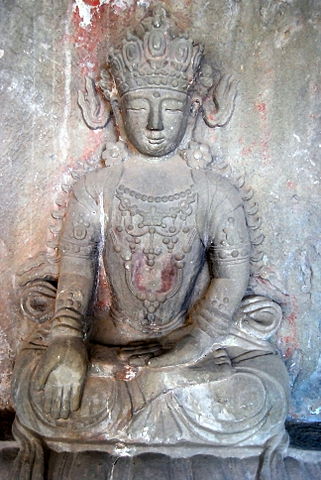Just last post I was whining about meditation and how my erstwhile suitor always jettisons me after a torrid courtship. He’s a fickle sort, my tormentor, but he seems to have settled in for the long haul this time around. What happened? you ask. Wish I knew.
All I know is that a month ago, my husband and I were thrust into a chaotic situation in dealing with my mother-in-law’s medical treatments after her stroke. We’d thought she’d been recovering, but the truth was something far worse than we’d guessed. Suffice to say, a thousand miles from home and sanity, both of us came unraveled. And, somehow, in the unraveling, I finally found what everyone else in the universe finds in meditation.
For the first time in the months I’d been floundering and flailing, I actually found a moment’s peace. Everything went quiet, and just for the five minutes of guided meditation, I was still and in myself fully. Maybe all of the pain had finally set me up for a breakthrough, or maybe I was having a breakdown. Either way, meditation has been almost easy ever since.
You’ll note the almost. Meditation is a discipline, and when you’re a space cadet like yours truly, discipline isn’t something that will ever feel fully natural. Here are a few things I’ve learned in the process:
1. The time to begin meditating is before you truly need it.
Your breath is coming harsh in your lungs. Bands tighten across your chest when you try to inhale. Your thoughts circle in your skull, around and around, racing the Indy 500. You think, “I should learn to meditate.”
That was me, trying to head off editing’s anal madness. And it was the wrong time. When you sit and observe your breath when you can’t actually breathe, you create a feedback loop that just intensifies your anxiety as your ever-shallower breaths turn into soup in your lungs. And then you panic.
If you’re not currently anxious, start meditating now, so you have a coping tool when the tough times hit. Meditation can be a valuable tool for easing anxiety if you’ve sharpened your skills before it takes hold.
2. Don’t feel stuck with your current form of meditation if it isn’t working for you.
When you’re anxious, you don’t want to focus on mindful breathing. A body scan or chanting a mantra might be more effective. When you’re feeling furious, you probably don’t want to focus on unconditional love (metta). Instead, perhaps, mindful breathing might work better. When you’re feeling jumpy and overwhelmed, you might not feel comfortable sitting. Maybe a moving meditation or yoga might be more helpful.
If you’re having issues with a particular type of meditation, maybe you shouldn’t keep forcing yourself to practice. Keep an open mind and be willing to try something new.
3. Start slowly and if that’s too fast, take it even slower.
You’ve probably read what I have—that you should aim for twenty minutes of meditation a day. Even the wimpiest meditation trainers I’ve found on Google Play start at five minutes per session before jacking you up to ten minutes within a couple of weeks.
That’s too fast. It definitely was for me. Five minutes of observational breathing to someone completely untrained feels like five centuries.
Scale back. A lot.
In the heart of my most anxious moments, I found two minutes to be almost more than I could handle. Even then, I had to baby myself by keeping my eyes open—closed brought me panic attacks—and by watching a timer visually count down on my tablet as I counted my breaths.
Two minutes of extremely controlled, deep breathing actually relaxed me. It was the first time “meditation” actually felt like it was supposed to.
4. If you’re learning how to practice from a book, make sure the program style fits your personality.
I think I wrote about my joys in dealing with Meditation for Your Life: Creating a Plan that Suits Your Style by Robert Butera. I thought, “Bingo!” Most things don’t suit my style because I’m weird. This book didn’t either, despite its five-star rating on Amazon. It’s one of those, “make your entire life revolve around meditation” books, delving into every irrelevant aspect of your existence. Maybe the process works for some, but for me, well…
I really hate wasting time. Time dredging up endless past emotions just to be told, “The only thing that works is trial and error.” I’m not bitter. Really.
I’ve personally had better luck with 8 Minute Meditation: Quiet Your Mind. Change Your Life. by Victor Davich. It’s a straightforward, breezy look at meditation, introducing a progressively more difficult form of meditation for each of the eight weeks of the program. I’m finding its deceptive simplicity almost profound and a hell of a lot easier to deal with. I’m on Week 5 of the program, “Gracious Declining,” and I’m finding I’m a lot more focused these days.
You might not, however. You might like Butera’s book, or (in my view) the surprisingly obtuse Mindfulness in Plain English by Henepola Gunaratana. Or the classic, but very mystical, Wherever You Go, There You Are by Jon Kabat-Zinn.
If the book you’re reading and practicing from isn’t working, dump it quickly and move on to whatever suits you the best, otherwise all you’ll court is frustration.
5. Find your proper time of day to meditate.
This is, I think, the real biggie. I was meditating midday and wondered why I kept falling asleep late in the afternoon. Meditating at the wrong time can be more destructive to your energy levels than not meditating at all.
Davich, in 8 Minute Meditation, recommends meditating either when you first wake up before your morning coffee, or before you go to bed. I’ve started meditating an hour or two before I go to sleep, and suddenly, the meditational energy drain is gone. I also sleep better because my mind has stopped racing.
That doesn’t mean either of those times will be better for you. Experiment. Maybe you’ll be better off taking a few deep breaths during your lunch break or after you get off work. Just like any other aspect of meditation, timing can be equally important to your success or failure.
I hope a few of these tips might make your journey into the deeper realms of consciousness a little more bearable than mine. Good luck!



